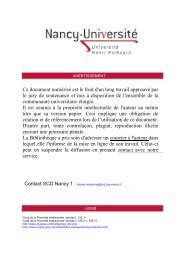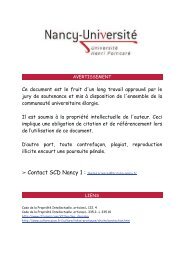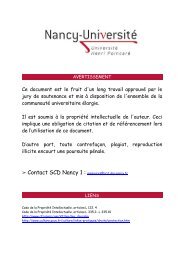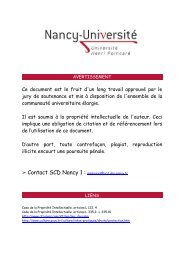Ce document numérisé est le fruit d'un long travail approuvé par le ...
Ce document numérisé est le fruit d'un long travail approuvé par le ...
Ce document numérisé est le fruit d'un long travail approuvé par le ...
Create successful ePaper yourself
Turn your PDF publications into a flip-book with our unique Google optimized e-Paper software.
23. Bradbury, J., C. Niemeyer, T. Da<strong>le</strong>, and P. Edwards. Alterations of the growth characteristics<br />
of the fibroblast cell line C3H 10T1/2 by members of the Wnt gene family. Oneogene 9: 2597-2603,<br />
1994.<br />
24. Bradford, M. A rapid and sensitive method for the quantitation of microgram quantities of<br />
protein utilizing the principal of protein-dye binding. Anal Bioehem 72: 248-254, 1976.<br />
25. Braissant, O., F. Foufel<strong>le</strong>, C. Scotto, M. Dauca, and W. Wahli. Differentiai expression of<br />
peroxisome proliferator-activated receptors (PPARs): tissue distribution of PPAR-alpha, -beta, and <br />
gamma in the adult rat. Endoerinology 137: 354-366, 1996.<br />
26. Braissant, O., and W. Wahli. Differentiai expression of peroxisome proliferator-activated<br />
receptor-alpha, -beta, and -gamma during rat embryonic development. Endoerinology 139: 2748-2754,<br />
1998.<br />
27. Brandt, J. M., F. Djouadi, and D. P. Kelly. Fatty acids activate transcription of the musc<strong>le</strong><br />
carnitine palmitoyltransferase 1 gene in cardiac myocytes via the peroxisome proliferator-activated<br />
receptor alpha. J Biol Chem 273: 23786-23792, 1998.<br />
28. Brockman, J. A, R A Gupta, and R N. Dubois. Activation of PPARgamma <strong>le</strong>ads to inhibition<br />
of anchorage-independent growth of human colorectal cancer cells. Gastroenterology 115: 1049-1055,<br />
1998.<br />
29. Buffa, R, C. Capella, P. Fontana, L. Usellini, and E. Solcia. Type of endocrine cells in the<br />
human colon and rectum. <strong>Ce</strong>l/ Tissue Res 192: 227-240,1978.<br />
30. Burmer, G., and L. Loeb. Mutations of the KRAS2 oncogene during progressive stages of<br />
human colon carcinoma. Proe Natl Aead Sei USA 86: 2403-, 1989.<br />
31. Bussey, H. Familial polyposis coli. Johns Hopkins University Press, 1975.<br />
32. Cablé, S., M. Kedinger, and M. Dauça. Peroxisomes and peroxisomal enzymes a<strong>long</strong> crypt<br />
villus rat int<strong>est</strong>ine. Oifferentiation 54: 99-108, 1993.<br />
33. Cabrera, C., M. Alonso, P. Johnston, R. Phillips, and P. Lawrence. Phenocopies induces with<br />
antisense RNA identify the wing<strong>le</strong>ss gene. <strong>Ce</strong>l/50: 659-663, 1987.<br />
34. Camp, H. S., and S. R. Tafuri. Regulation of peroxisome proliferator-activated receptor y<br />
activity by mitogen-activated protein kinase. J Biol Chem 272: 10811-10816, 1997.<br />
35. Camp, H. S., A L. Whitton, and S. R. Tafuri. PPARgamma activators down-regulate the<br />
expression of PPARgamma in 3T3-L1 adipocytes. FEBS Letters 447: 186-190, 1999.<br />
36. Casas, F., L. Domenjoud, P. Rochard, R. Hatier, A Rodier, L. Daury, P. Kremarik-Bouillaud,<br />
P. Becuwe, J. Kel<strong>le</strong>r, H. Schohn, C. Wrutniak-Cabello, G. Cabello, and M. Dauça. A 43 kDa protein<br />
related to PPARy2,induces by peroxisome proliferators, is located in the mitochondrial matrix. FEBS<br />
Letters 478: 4-8, 2000.<br />
37. Casas, F., T. Pineau, P. Rochard, A. Rodier, L. Daury, M. Dauça, G. Cabello, and C.<br />
Wrutniak-Cabello. New mo<strong>le</strong>cular aspects of regulation of mitochondrial activity by fenofibrate and<br />
fasting. FEBS Letters 482: 71-74, 2000.<br />
38. Catt<strong>le</strong>y, R C., J. DeLuca, C. Elcombe, P. Fenner-Crisp, B. G. Lake, D. S. Marsman, T. A.<br />
Pastoor, J. A Popp, D. E. Robinson, B. Schwetz, J. Tugwood, and W. Wahli. Do peroxisome<br />
proliferating compounds pose a hepatocarcinogenic hazars to humans ? Regul. Toxieol. Pharmaeol.<br />
27: 47-60,1998.<br />
39. Chang, T., and E. Szabo. Induction of differentiation and apoptosis by ligands of peroxisome<br />
proliferator-activated receptor y in non-small cell lung cancer. Cancer Res 60: 1129-1138, 2000.<br />
40. Chattopadhyay, N., D. P. Singh, O. Heese, M. M. Godbo<strong>le</strong>, T. Sinohara, P. M. Black, and E.<br />
M. Brown. Expression of peroxisome proliferator-activated receptors (PPARs) in human astrocytic<br />
cells: PPARy agonists as inducers of apoptosis. J. Neurosci Res 61: 67-74, 2000.<br />
41. Chawla, A, Y. Barak, L. Nagy, D. Liao, P. Tontonoz, and R. M. Evans. PPAR-y dependent and<br />
independent effects on macrophage-gene expression in Iipid metabolism and inflammation. Nature<br />
Med 7: 48-52, 2001.<br />
42. Chawla, A, E. J. Schwartz, D. D. Dimaculangan, and M. A Lazar. Peroxisome proliferatoractivated<br />
receptor (PPAR)-y. adipose-predominant expression and induction early in adipocyte<br />
differentiation. Endocrilogy 135: 798-800, 1994.<br />
43. Chen, Z., S. lshibashi, S. Perrey, and e. al. Troglitazone inhibits atherosc<strong>le</strong>rosis in<br />
apolipoprtein E-knoutout mice. Atheriose<strong>le</strong>r Thromb Vase Biol 21 : 372-377, 2001.<br />
44. Cheng, H., and C. Leblond. Origin and differentiation of the four main epithelial cell types in<br />
the mouse small int<strong>est</strong>ine. V. Unitarian origin of the four epithelial cell types. Am J Anat 141: 537-562,<br />
1974.<br />
45. Cherkaoui-Malki, M., Y. C. Lone, M. Corral-Debrinski, and N. Latruffe. Differentiai protooncogene<br />
mRNA induction from rats treated with peroxisome proliferators. Bioehem Biophys Res<br />
Commun 173: 855-861, 1990.<br />
112
















